The Dell XPS 13 7390 2-in-1 Review: The Ice Lake Cometh
by Brett Howse on November 15, 2019 11:30 AM ESTBattery Life
Always a key metric on a mobile device, the Dell XPS 13 has historically offered excellent battery life. With the latest 10 nm processor, expectations are high. Dell keeps the battery capacity similar to the non-convertible model, officially rated for 51 Wh and with 50 Wh usable. Considering the small size of the device, the battery capacity is quite good, although a step down from the 60 Wh seen on the older models such as the 9360. But, battery capacity is only one part of the equation, with platform efficiency being the other.
To see how the XPS 13 7390 2-in-1 performs, we standardize the display brightness to 200 nits, and run it through three tests. The light test is very light web browsing. Our 2016 Web test is much more demanding and pulls a lot more CPU power into the equation. Finally, we test for video playback, which can often be the longest runtime due to the offloading of the video decode.
Light Web
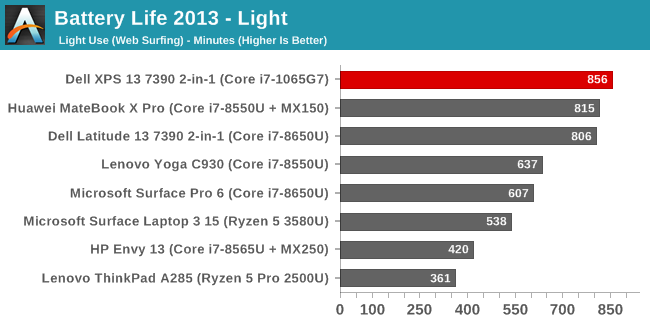
The XPS 13 7390 gets off to a strong start. Despite the larger physical display of the 16:10 13.4-inch panel, and the smaller battery capacity than some of the competition, the XPS 13 jumps to the top of the chart with over 14 hours of runtime on this light workload.
2016 Web

Our more demanding test always makes a big impact on efficient devices, forcing them to use the CPU a lot more and therefore using more power. But the Ice Lake platform does very well, maintaining its standing at the top with just a hair under 12 hours of runtime. Very impressive.
Movie Playback
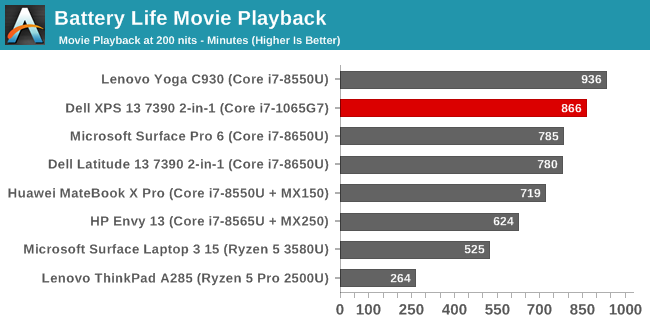
As we've seen in laptops over the last few years, Intel's now last-generation integrated UHD 620 GPU offers some spectacular battery life under video playback, as evidenced by how much longer these devices last in our video playback test, versus the more mixed workloads of our light web test. However things are a lot closer for the XPS 13; the Iris Plus (G7) GPU-equipped laptop only achieved ten minutes additional battery life over the light test. One device is not enough to make a definitive conclusion, but early indicators are that the norms for power consumption have changed on Intel's chips, and that movie playback and other ultra-light workloads that stress the GPU more than the CPU no longer hold a big advantage in power consumption. That being said, the device still achieved excellent battery life in this test, only being beaten by one other modern Ultrabook we’ve tested.
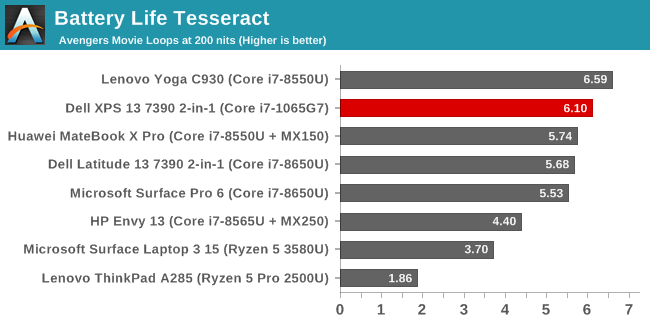
Our Tesseract score divides the movie playback time by the length of a long movie – The Avengers – to give a more practical view of the movie playback. If you had to, you could watch The Avengers six times in a row before needing to plug the laptop in.
Normalized Results

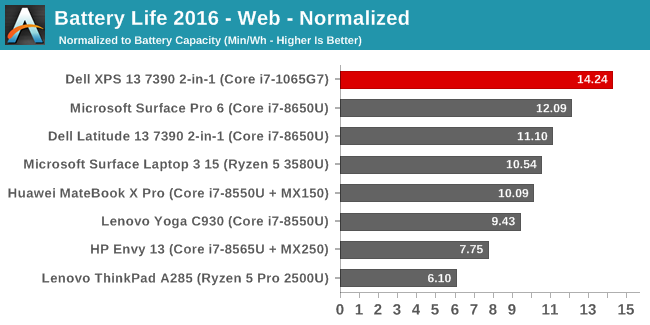
By removing the battery size from the equation we can get a peek at the platform efficiency, and the results are excellent for the first Ice Lake system we’ve tested. Much like how the first move to 14 nm in Broadwell brought a significant decrease in power usage, the XPS 13’s 10 nm Ice Lake platform achieves a significant step forward in efficiency in both our very light test, which is mostly idle time with small bursts of work, as well as the 2016 test which is much more demanding on the CPU.
The system power draw at idle, including the display power which is always the largest draw, is only around 3 Watts, which is quite good.
Battery Life Conclusion
Dell’s XPS 13 7390 2-in-1 brings a nice step forward in overall battery life, and unlike some of Dell’s earlier offerings it doesn’t try to do too much with excessive Content Adaptive Backlight Control which was a hindrance on older models of the XPS 13. For the current generation, CABC doesn’t appear to be leveraged at all.
With class-leading efficiency, the slightly smaller battery capacity is not a hindrance at all, with the Dell achieving excellent battery life results regardless of the 50 Wh of battery capacity.
Charge Time
Dell utilizes a Type-C charging adapter, which is always welcome on a modern laptop. The unit shipped with the XPS 13 2-in-1 is just a 45-Watt charger though, which is plenty to power this very efficient machine, but not enough power to provide much in the way of fast charging. With Express Charging enabled and the machine off, Dell claims 80% in one hour, but that goes down if the machine is on.
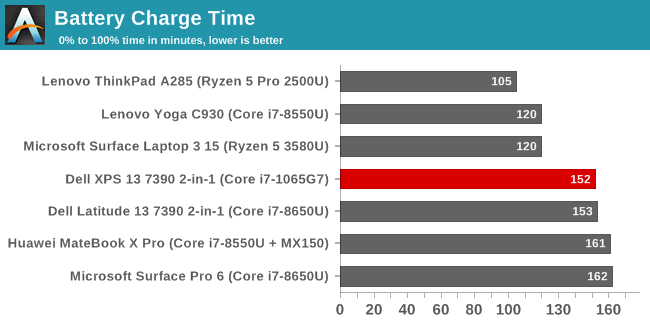
Overall charge time came in about average, at just a smidge over 2.5 hours. If you need more power and expansion, Dell offers a Type-C dock with a 130-Watt adapter, as well as a Thunderbolt dock with a 180-Watt power source.










108 Comments
View All Comments
ikjadoon - Friday, November 15, 2019 - link
This is actually huge. Huawei & Microsoft couldn't move the 16:9-fanatics alone: I'm glad Dell did this.Lenovo has forsaken their roots with their infatuation with 16:9 in 2019.
Color me surprised that Dell was first to commercialize user feedback into an actual product (i.e,. what Huawei, Microsoft, and Apple have known for the better part of a decade).
ToTTenTranz - Friday, November 15, 2019 - link
Will you guys have the new Spectre 13 X360 with a 4K AMOLED display?It's a heavy competitor to the XPS 13 due to the new chassis with much smaller bezels, and it's also using Ice Lake.
Beltendu - Thursday, November 21, 2019 - link
Really looking forward to this. It's not exactly apples to apples (eg, no 1980x1200 on the Spectre), but similar specs otherwise comes out cheaper. I'd love to know the difference once it's in someone's hands.tipoo - Friday, November 15, 2019 - link
I'm largely left wondering what the heck the whole point of the AMD APU in the Surface Laptop 15 was, they pitched it as the best graphics performance "in this class" (comparing their 15" against the MBP 13"...), and it doesn't even distance itself from Ice Lakes IGP here.danielfranklin - Friday, November 15, 2019 - link
Surely its all about next years model.They didnt have the 7nm and new arch this year, so they worked on the relationship and firmware.
Once AMD can bring them a modern APU, hopefully it will all pay off!
But for this year, CPU barely keeps with with Intel's old CPUs, GPU matches Intel's Icelake. So yeah, pointless right now.
tipoo - Saturday, November 16, 2019 - link
Perhaps. I had been hoping this would be a debut 7nm AMD part, but the 12nm APU leaves me whelmed.Alistair - Friday, November 15, 2019 - link
AMD CPU and GPU is faster for the money. The GPU reviewed here is for the top model, the $1500 model.Alistair - Friday, November 15, 2019 - link
the i3 and i5 models have less than half the speedskavi - Friday, November 15, 2019 - link
The Surface Laptop 3 13.5" uses G7 graphics in the base model, which is $200 less than the base 15".Alistair - Saturday, November 16, 2019 - link
And if you want the 15" with the same processor it is $100 more? You are comparing two different laptops, not just two different processors.